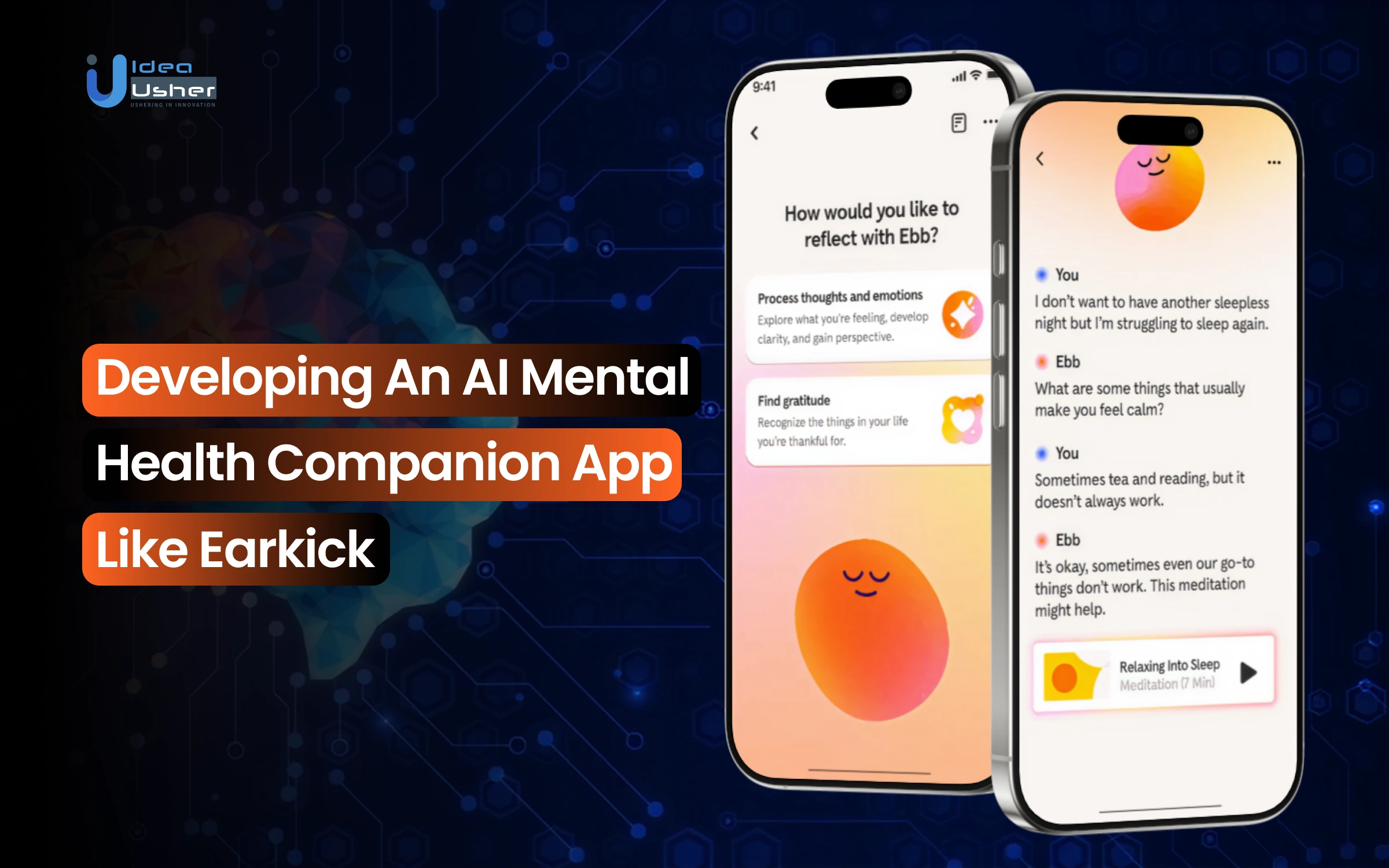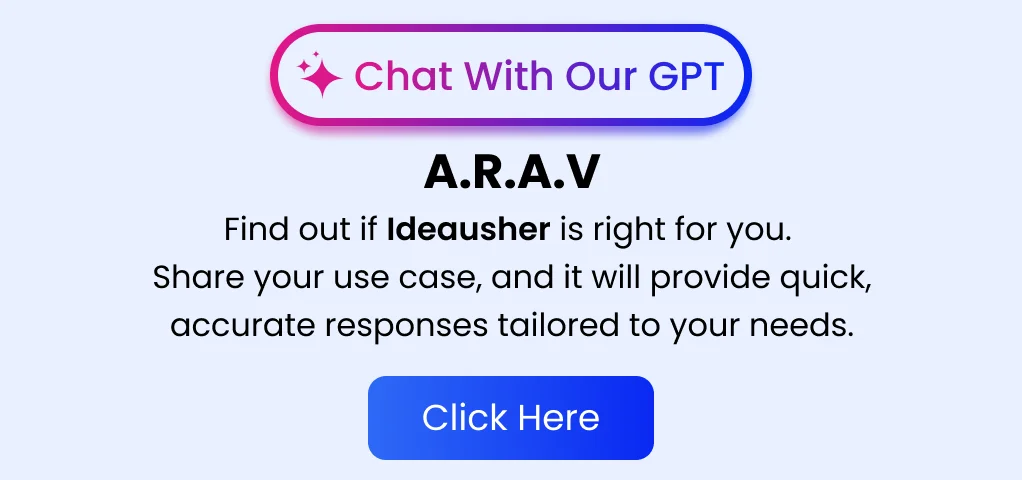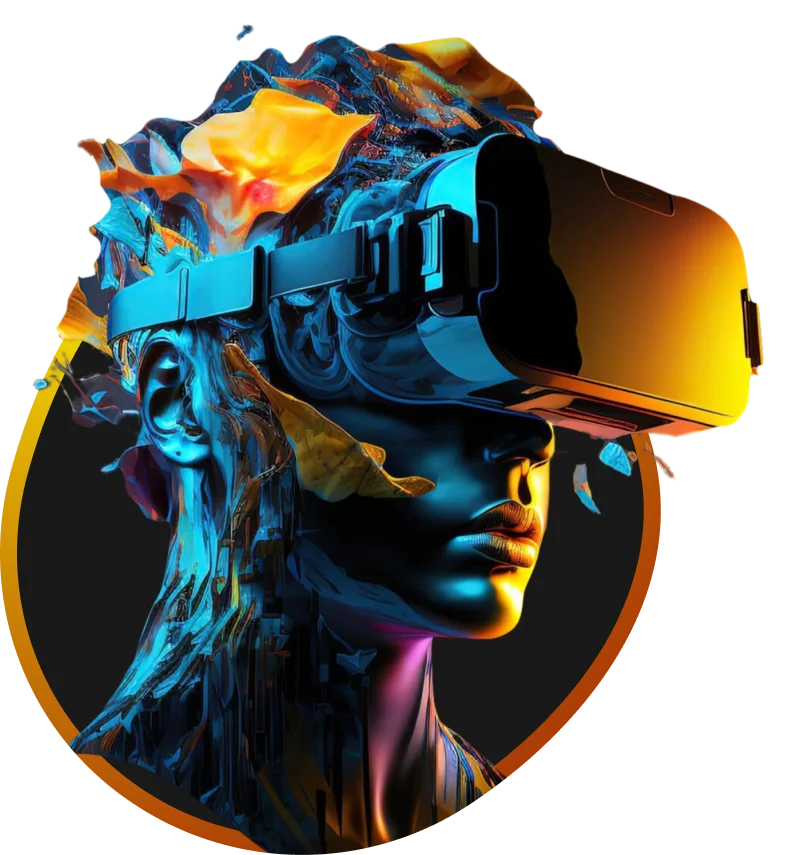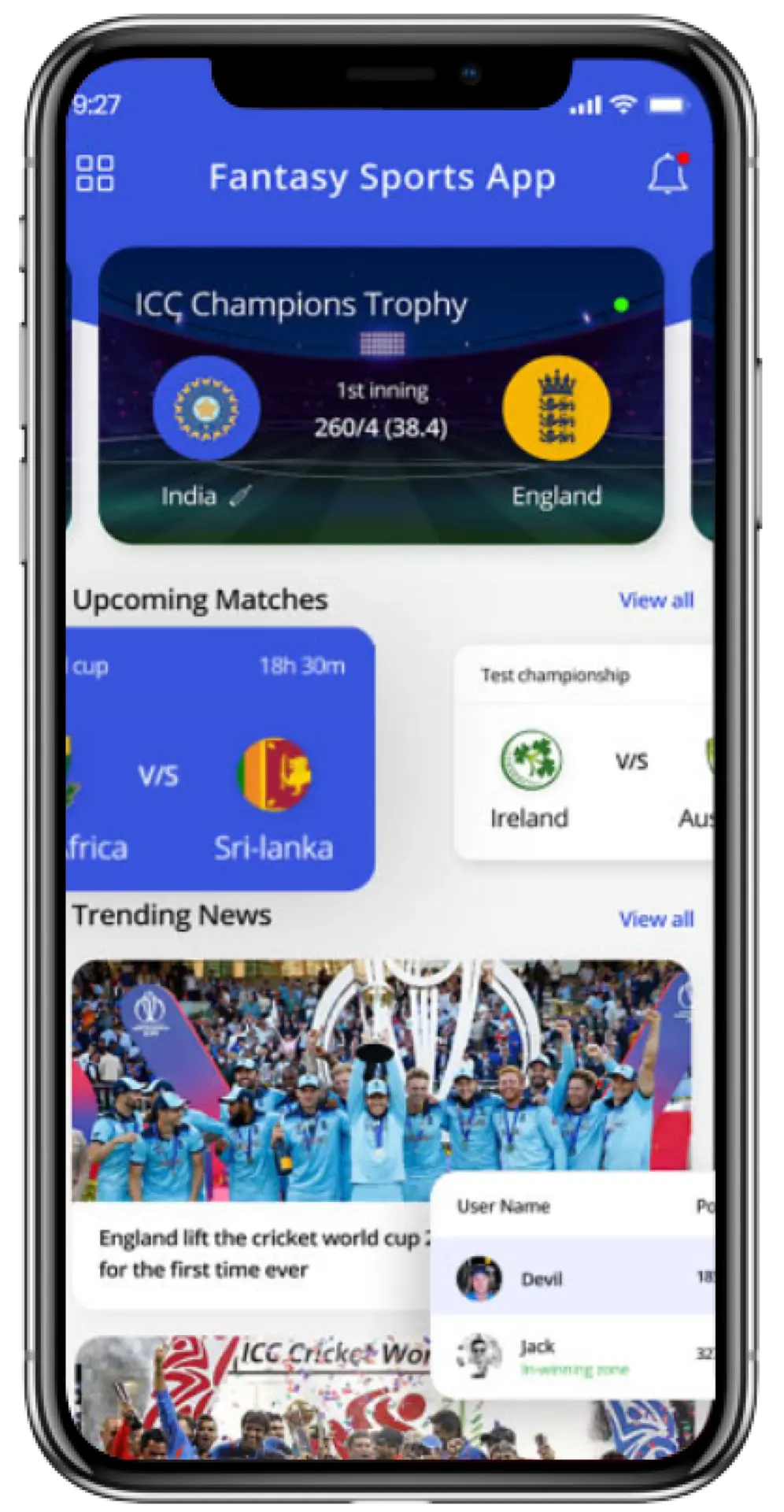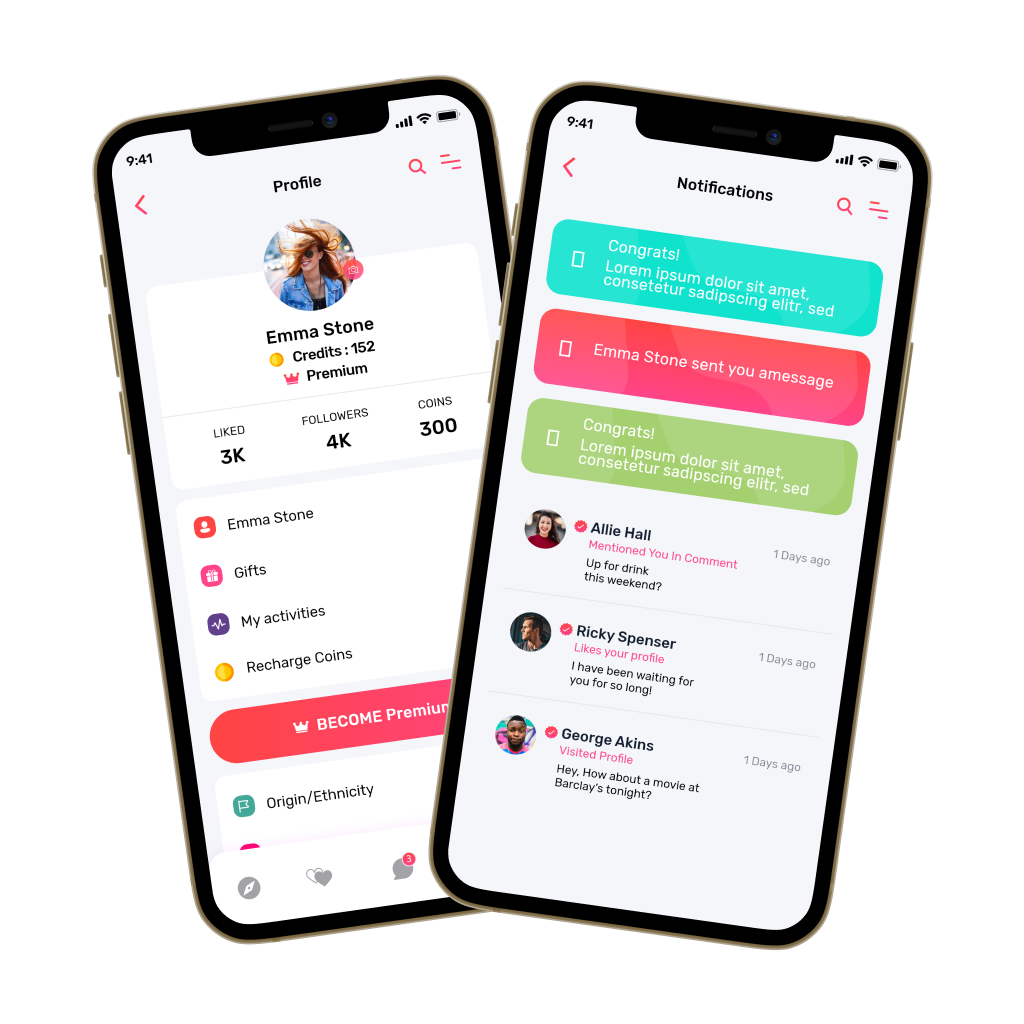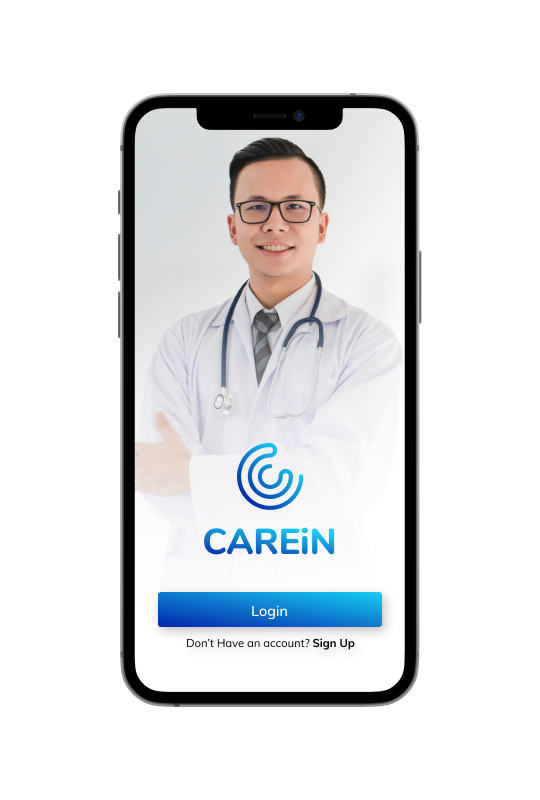Mental health today is often a quiet struggle, hidden behind busy schedules and fake smiles. With constant work pressures and the need to stay “okay,” it can be hard to make room for emotions. People need accessible support now more than ever, and technology is stepping in to help.
AI mental health apps like Earkick are changing the way we manage our emotional well-being. They don’t replace human care, but offer quick check-ins and mood tracking that can make a real difference. Healthcare businesses now have a great opportunity to invest in this lucrative market by launching their own AI mental health solutions.
In this blog, we’ll dive into how an AI mental health companion app like Earkick is developed. We’ll cover everything from its core purpose and features to the technology and design choices that make it work so well. Our team at IdeaUsher has technical expertise with a deep understanding of mental health needs to build scalable platforms that users trust, as we have worked on and with many healthcare platforms and organizations to either digitize or make new technology for them.
Key Market Takeaways for Mental Health Companion Apps
According to GMInsights, the market for mental health companion apps is growing rapidly. It reached USD 14.1 billion in 2024 and is set to expand at a rate of 26.8% annually through 2034. This growth is driven by a growing awareness of mental health issues and the rise of AI technology, which makes mental health support more accessible and personalized.
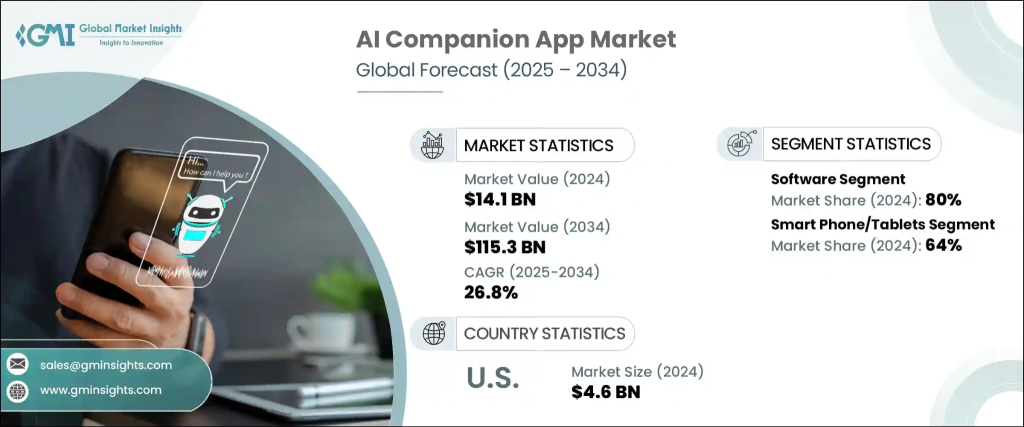
Source: GMInsights
As more people look for on-demand support, these apps have become increasingly popular. They offer users a way to manage stress, anxiety, and depression privately and conveniently. Tools like mood tracking and personalized reminders allow users to get the support they need, especially during difficult times like the pandemic.
Leading examples like Woebot, Wysa, and Replika are paving the way, offering real-time emotional support through AI. Strategic partnerships have played a big role in their growth, such as Woebot’s collaborations with health systems and Wysa’s work with major organizations like Accenture and the NHS. These alliances help amplify the impact of AI mental health solutions on a global scale.
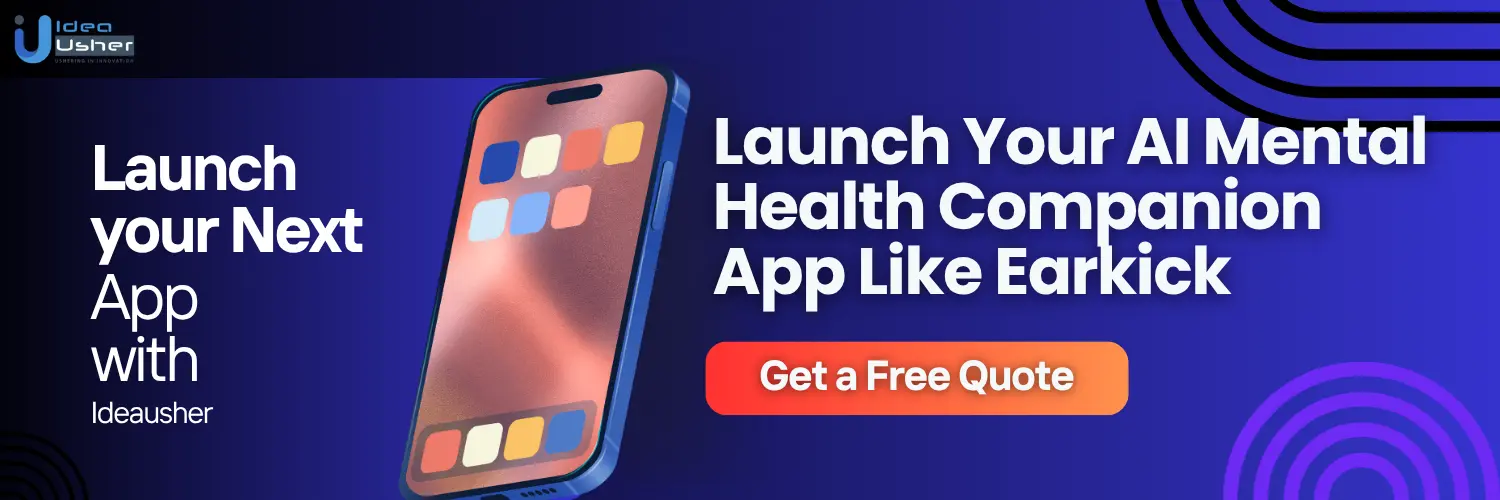
What is the Earkick App?
Earkick is a mental health app that puts privacy first. It’s powered by AI and designed to help users track and improve their mental well-being in real time. The app features a friendly AI companion, often shown as a panda, which offers immediate support. Users don’t need to register or share any personal data. It’s all about giving users a safe and private space to work on their mental health.
Key Features That Make Earkick Stand Out
Complete Privacy and Anonymity
With Earkick, there’s no need for an account or registration. It doesn’t track your data. Everything stays either on your device or encrypted in iCloud. This way, you remain in control of your own mental health journey.
AI-Powered Personal Coach
The app’s AI analyzes your voice, mood, and behavior. It can even track your heart rate through the Apple Watch. This helps the AI give personalized advice based on how you’re feeling right now, not just some generic tips.
3-Second Check-ins and Effortless Tracking
Earkick makes it easy to check in on your mental state. You can use voice, text, or video to track your mood, stress, or anxiety in just a few seconds. The app even takes into account things like location and weather to offer more personalized insights.
Guided Self-Care and Evidence-Based Tools
The app offers meditation, breathing exercises, soundscapes, and cognitive-behavioral techniques. It also includes a “panic button” feature for immediate help when you need it most. These tools are designed to help you feel better right away.
Progress Visualization and Habit Building
Earkick helps you track your mental health progress over time. It visualizes trends and offers insights to help you understand your patterns or triggers. The app also helps you build healthy habits and routines that can lead to long-term improvements.
Real-Time, 24/7 Accessibility
Earkick is available whenever you need it. The AI is always there to support you, with customizable interactions. Whether you need a calm, motivational, or supportive tone, the app adjusts to how you want to feel in that moment.
Apple Ecosystem Integration
Earkick works seamlessly with the Apple ecosystem. It connects with your Apple Watch and Apple Health, so your mental health check-ins are linked to physical metrics like heart rate, sleep, and activity. This gives you a fuller picture of your well-being.
How Does the Earkick App Work?
Earkick works by offering users a simple and private way to track their mental well-being. It uses AI to analyze mood, voice, and biometrics to provide personalized support. The app adapts to users’ needs and helps them manage their mental health without requiring personal data or sign-ins.

1. The Onboarding
Earkick makes it super simple for users to get started. There’s no need to enter an email or create a password. Users just download the app and dive right in. This quick access removes any barriers, allowing anyone to start tracking their mental health without worrying about their data being exposed.
2. The Dashboard
When users open the app, they’re greeted by a clean and easy-to-use dashboard. In the center is the “Mental Readiness Score,” which gives users a quick overview of their current mental state. It’s a simple number that reflects their mood and provides a snapshot of how they’re feeling. The dashboard also offers quick links to key features like:
- Track: Log mood
- Routines: Build healthy habits
- Talk: Chat with the AI companion, Panda
- Learn: Access helpful tools like breathing techniques
3. The Tracking
Tracking mood is easy and flexible. Users can log their feelings in different ways that feel comfortable to them.
The 3-Second Check-In: A quick tap on the “Track” button lets users select their mood with a simple slide. It’s quick and easy.
Voice & Video Memos
If users need to express more, they can record a short voice or video memo. The AI doesn’t just transcribe, it listens to their tone, pace, and energy to provide a better understanding of how they’re feeling.
Biometric Integration
If users sync their Apple Health or Apple Watch, the app tracks heart rate, sleep, and activity levels. This data gives a more complete view, connecting physical and mental health. For example, Earkick may show that anxiety levels are high while heart rate variability points to stress in the body as well.
4. The AI Companion: Conversing with “Panda”
At the core of Earkick is the AI companion, Panda. It’s not just a generic chatbot but an AI based on principles from CBT and DBT.
- Real-Time Conversations: Users can talk to Panda about anything on their mind. It listens without judgment and offers support when needed.
- Structured Guidance: Panda also leads users through self-care exercises like meditation and breathing techniques to help with overwhelming feelings.
- Personalization: Users can choose how they want Panda to interact. Whether they want a “Calm Listener” or a “Motivational Coach,” the app adapts to their needs.
5. The Foundation
Earkick helps users build healthy habits and manage stress proactively. It offers tools like daily routines, breathing exercises, and immediate links to emergency resources when needed. Users can easily access practical techniques anytime to support their mental well-being.
Behind the Scenes: A Technical Glimpse
So, how does Earkick keep things private while offering all these features?
- On-Device AI: Most of the AI processing happens right on the users’ device. This means sensitive data like voice memos or chat history doesn’t leave their phone.
- Data Abstraction: The app collects anonymous, aggregated data to improve itself over time. It tracks trends without ever needing to know who the user is.
This approach makes Earkick a safe and private mental health tool that users can trust to provide support when they need it.

What is the Business Model of the Earkick App?
Earkick offers a free version with essential features and a premium subscription for those who want additional tools to improve their mental health. Users can choose from monthly, annual, or family plans, which unlock personalized support and extra conveniences. The app is expected to generate around $1.1 million in annual revenue by mid-2025, reflecting strong demand and engagement.
User Engagement and Growth
- The app has gained around 40,000 downloads, with users seeing improvements like a 32% reduction in anxiety and a 34% boost in mood in under six months.
- Its user base is growing steadily, with new members joining each month, especially from younger groups like students.
- This growth shows that people are finding real value in what Earkick offers.
Financial Performance
In 2022, Earkick had a monthly burn rate of about $10,733, which gave it a runway of 13.3 months. Despite these early-stage costs, the company has managed to keep a solid financial footing. With 18 full-time employees, the revenue per employee is around $62,100, which reflects a healthy balance between growth and sustainability.
Funding and Valuation
Earkick has raised about $1.47 million through various funding rounds. This includes a $1 million pre-seed investment in 2021, followed by $470,000 in a SAFE note in 2023, and $57,000 from a Wefunder campaign in 2024.
As of April 2024, the company was valued at $12.5 million. Investors, including the Duke Impact Investing Group, have been drawn to the app’s social impact focus. These funds help support Earkick’s technology development and market expansion.
Strategic Positioning
Earkick stands out as an AI-powered mental health companion that tracks mental wellness and offers real-time support.
By using proprietary AI models and integrating physiological data, it offers a unique value proposition in a market crowded with over 30,000 mental health apps. This approach helps users get more personalized and actionable insights.
Effective Revenue Strategies for an AI Mental Health App
While the freemium subscription model has worked well for Earkick, there are other effective ways to generate revenue for an AI mental health companion app.
1. The B2B2C Enterprise Wellness Model
This model involves selling the app as a benefit to businesses, universities, or health insurers. Companies can purchase bulk licenses to offer the app as part of an Employee Assistance Program or a corporate wellness initiative. The app can even be white-labeled with the company’s branding.
How it Works: Employers provide the app to employees to reduce burnout and improve productivity. For health insurers, the app serves as a cost-effective tool to reduce claims related to mental health.
Why It Works?
The corporate wellness market is expected to surpass $90 billion by 2030. Apps like Calm have thrived in this space, with companies like Nike and Starbucks using Calm for Business. By offering anonymized, aggregated data on workforce well-being, employers can see clear ROI, which helps justify the investment.
2. The Tiered Human-Coach Hybrid Model
While AI is great for self-care, human support is sometimes necessary. This model combines the power of AI with access to licensed therapists or coaches, creating a smooth transition from digital support to professional care.
How it Works: Users can start with AI-only support and then choose to upgrade to tiers that include sessions with a coach or therapist. For example, the app could offer:
- Tier 1: AI Companion (free or freemium)
- Tier 2: AI Companion + two 30-minute sessions with a coach per month ($50-$80/month)
- Tier 3: AI Companion + weekly therapy sessions ($200-$300/month)
Why It Works?
The online therapy market is growing rapidly. Companies like Talkspace have seen significant success with subscription models. By offering triage support through AI, the app can create a cost-effective way for users to access professional help.
3. The Strategic API Licensing & White-Labeling Model
If the app’s AI and analytics technology are top-tier, it can be licensed out to other companies. This shifts the revenue model from B2C to B2B.
How it Works: You can package your AI technology into an API and license it to other companies. This allows them to integrate your advanced tools into their own platforms, expanding your reach and revenue.
Potential Clients:
- Other app developers (e.g., fitness apps integrating mental wellness data)
- Digital health platforms that need a 24/7 AI-powered companion
- Hardware companies like wearable makers who want to offer advanced mental health insights through their devices.
How to Develop an AI Mental Health Companion App Like Earkick?
We specialize in developing AI-driven mental health companion apps like Earkick for our clients. Having developed numerous successful apps in this space, our approach focuses on creating personalized, effective, and secure solutions that comply with privacy standards. Here’s how we develop these AI-driven apps step by step:

1. Define Therapeutic Framework
We begin by working closely with clinical psychologists to ensure the app is based on proven methods like CBT, DBT, and mindfulness. This helps the AI provide real, helpful support. We also create a library of therapeutic interactions that allows the app to adapt to each user’s needs.
2. Build Privacy-First AI Architecture
Privacy is at the heart of everything we do. We use on-device inference and end-to-end encryption to keep user data safe. The app also allows users to start using it without having to register, and all conversations are stored locally on their device.
3. Integrate Multi-Modal Tracking
We integrate different ways to track emotions, such as voice, text, and video recognition. The app can sync with HealthKit or Google Fit to track things like heart rate variability and sleep patterns. All this data is combined to give the user a mental readiness score that helps them understand their well-being.
4. Implement Ethical and Safety Guardrails
Safety is a top priority. We include crisis response features and set up keyword triggers to ensure the app responds appropriately. We also conduct regular audits to make sure the AI’s tone is right and that the app meets all privacy standards like HIPAA and GDPR.
5. Personalization Without Identity
The app personalizes content without ever using identifiable information. We use data trends, like “stress triggers: work,” to provide tailored support. Users can track their progress over time, but their identity remains protected because everything is stored locally.
6. Launch, Test, and Iterate
Before we launch, we test the app with mental health professionals to make sure it works well. We refine the app based on feedback and continue to improve it as more people use it. Once everything is fine-tuned, we scale up and keep updating the app to maintain high standards.
Common Challenges in an AI Mental Health Companion App
After working on AI mental health apps with many clients, we’ve learned a lot about the common challenges. It’s more than just building a chatbot, it’s about ensuring the AI genuinely supports someone’s well-being. We’ve figured out the best ways to handle these issues through experience and practical solutions.
1. The Empathy-Safety Paradox
We all want an AI companion that feels empathetic, like talking to a friend. But the tricky part is making sure the AI doesn’t go off track. Without proper safeguards, it might:
- Invent things: It could come up with a therapy technique that doesn’t exist.
- Validate harmful beliefs: The AI might confirm the user’s wrong ideas or delusions.
- Give medical advice: It could suggest medication doses or even try diagnosing the user.
The Solution
To make sure the app works well, we create structured scripts that follow proven methods like CBT and DBT. We also fine-tune the AI with real therapist-patient conversations so it stays aligned with professional standards. In a crisis, we make sure the AI directs users to emergency resources instead of continuing the conversation.
2. The Data Fusion Dilemma
Apps like Earkick rely on data from text, voice, and even things like heart rate. But sometimes these inputs don’t match up. For instance:
- A user might say “I’m fine” in their text but sound stressed when they speak.
- Their heart rate could be calm, yet they feel anxious.
The Solution
The key is using fusion algorithms that weigh different data sources based on the situation. If a user is in crisis, their words might matter more than their heart rate. We also ensure the algorithm is clinically validated to keep the AI’s insights grounded in real-world practices.
3. The Anonymous Engagement Problem
Earkick’s no-registration model offers great privacy but also makes personalization challenging. Without knowing who the user is, it’s tough to keep them engaged. However, we’ve found ways to offer value and encourage users to return without needing any personal data.
The Solution
Here’s how we tackle it: we use on-device memory.
- The app tracks user behavior, such as anxiety patterns or preferred exercises, without storing personal data.
- It uses anonymized tokens to store patterns, like [User_ID_XYZ]: “Sunday_Anxiety,” and recommends a suitable exercise.
- A feedback loop helps users see their progress, motivating them to continue using the app even without an account.
4. The Integrity Erosion
AI models can shift over time. One issue is model drift, where the AI might become less accurate as language and behavior change. Another concern is ethical drift, where the AI might develop biases or stray from its intended purpose.
The Solution
We conduct regular audits with independent experts to ensure the AI is safe and empathetic. We also have a governance framework that guides updates based on ethical principles like “do no harm.” If the AI drifts from its purpose, we retrain it with updated data to keep it aligned.

Revenue Potential of an AI Mental Health Companion App
The AI mental health market is one of the fastest-growing sectors within the digital health industry. With the right strategy, a well-designed AI-powered mental health app can quickly scale and generate significant annual revenue.
1. Market Sizing & Addressable Audience
To understand the potential of this market, we must first look at its size. Mental health disorders like anxiety and depression affect over 700 million people worldwide. A reasonable estimate suggests that 10% of this population, or 70 million people, might be willing to try a digital mental health app.
For a new app, a realistic target might be capturing 0.1% of this market within the first few years, which would equate to around 70,000 active users.
2. Revenue Model Breakdown & Financial Projections
The success of an AI mental health app relies on multiple revenue streams. A hybrid revenue approach can drive growth and profitability.
Assumptions for Year 1-5 Projections:
- User Growth: From 70,000 users in Year 1 to 1 million by Year 5.
- Conversion Rate: A typical freemium app converts 2-5% of users into paying customers. We’ll assume a conservative 3% conversion rate.
- Average Revenue Per Paying User: We’ll use a blended average of $120/year.
Revenue Stream 1: Freemium B2C Subscription
For the basic subscription, users get access to free content, while the premium plan costs $14.99 per month or $99 annually.
Year 1 Projections:
- 70,000 Monthly Active Users (MAUs) * 3% conversion = 2,100 paying users.
- Blended ARPPU of $120/year.
- Year 1 Subscription Revenue: 2,100 * $120 = $252,000.
For example companies like Calm and Headspace have successfully used a freemium model. Woebot, a direct competitor, also follows this model and has proven its potential for scaling with user acquisition.
Revenue Stream 2: B2B2C Enterprise Sales
B2B sales, especially to employers and health plans, offer high-margin, recurring revenue. Pricing typically ranges from $5 to $15 per employee per year (PEPY). We’ll use $10 PEPY for our projections.
Year 1 Projections:
- Target 10 small-to-medium enterprises with an average of 1,000 employees each.
- 10,000 employees * $10 PEPY = $100,000.
Companies like Headspace for Business and Ginger (now Headspace Health) show that enterprises place significant value on mental wellness programs. These B2B partnerships can become the highest-margin, most predictable revenue streams.
Revenue Stream 3: Hybrid Human-Guided Coaching
The hybrid coaching model adds a premium service for users who need more personalized support. Offering coaching sessions for $79 per month ($948 per year) can boost overall revenue.
Year 1 Projections:
- 70,000 MAUs * 0.5% conversion = 350 coaching subscribers.
- Year 1 Coaching Revenue: 350 * $948 = $331,800.
Platforms like Talkspace and BetterHelp show that online therapy can build a multi-million-dollar business. By offering coaching, the app could guide users into a higher-margin service, increasing overall revenue.
3. Path to $50M+ and Valuation Multiples
To reach $50 million in annual revenue, the app must focus on scaling both the enterprise business and hybrid coaching models.
Scenario: Scaling the Enterprise Business
By Year 5, securing just five Fortune 500 companies (with 50,000 employees each) at $10 PEPY would generate $25 million annually. Adding more SMEs and health plan partnerships could push this total to $30-40 million, possibly even higher.
Valuation Perspective
Digital health companies, especially those with scalable SaaS models, often trade at high revenue multiples. A typical multiple for a growing, asset-light digital health company is between 5x to 8x Annual Recurring Revenue.
Year 5 Projections: If the app generates $18.3 million in annual revenue, a 6x multiple would give it a valuation of about $110 million. If it reaches $50 million in revenue, its valuation could exceed $300 million.
Top Tools & APIs for AI Mental Health Companion App
To build an AI-powered mental health app, you’ll need AI and NLP tools to analyze user input and provide meaningful responses. Biometric integration with health platforms will offer a more complete picture of users’ well-being. Additionally, secure authentication and data encryption will be essential to protect user privacy and ensure compliance with relevant standards.

1. AI, NLP & Machine Learning
The core of the app relies on AI to understand and interact meaningfully with users.
Large Language Models
Powerful models like OpenAI’s GPT, Google’s Vertex AI, or Anthropic’s Claude form the foundation of the app’s conversational abilities. These models need to be fine-tuned with therapeutic dialogues to ensure they offer safe, relevant, and helpful interactions.
Specialized NLP Models
Using libraries like Hugging Face Transformers for tasks such as sentiment analysis or emotion detection is essential. For on-device sentiment analysis, something like DistilBERT can be used to ensure quick responses.
On-Device AI
TensorFlow Lite and PyTorch Mobile allow AI models to run directly on the user’s device, ensuring privacy and real-time analysis without sending data to the cloud.
2. Speech and Sentiment Analysis
The app doesn’t just understand what users say but also how they say it, providing deeper insights into their emotions.
- Speech-to-Text: OpenAI’s Whisper API converts voice and video memos into accurate text. For privacy, on-device STT models would be ideal to ensure data doesn’t leave the user’s phone.
- Sentiment & Tone Analysis: AWS Comprehend or IBM Watson Tone Analyzer help in identifying the emotions behind text, such as sadness, anger, or joy.
- Vocal Biomarker Analysis: APIs like Affectiva or Beyond Verbal analyze voice tone, pitch, and pace to identify underlying emotions, such as anxiety or stress, even when words seem neutral.
3. Biometric & Health Data
To get a complete picture of mental health, the app combines mood tracking with health data like heart rate and sleep patterns. Integrating wearable devices allows for even more detailed biometric insights. This helps users see how their physical state aligns with their mental well-being.
4. Security & Compliance
Security is crucial in mental health apps to protect user data and build trust. Authentication methods should allow users to start without sharing personal details, while encryption ensures data is safe. The app must also follow privacy regulations to handle data responsibly and safeguard user privacy.
5. Development Frameworks & Backend
These frameworks and tools tie everything together, from user interface to data management.
- Cross-Platform Development: React Native or Flutter allows for a single codebase to be used across both iOS and Android. This ensures consistency and speeds up development.
- Backend Orchestration: Node.js with Express.js is ideal for building a backend API that connects various services, from AI to data management.
- Database: PostgreSQL, with AES encryption, is used to store anonymized data, such as mood trends and the effectiveness of exercises, while ensuring that no personally identifiable information is stored.
Conclusion
The future of digital mental health is all about privacy-first, AI-powered companions that empower users while building trust. Earkick has shown that AI-driven tools can offer both empathy and ethics, providing real support for mental well-being. With Idea Usher’s expertise in federated learning, clinical-grade data fusion, and secure app architecture, businesses can confidently develop their own AI mental health platforms and take the lead in the next era of digital wellness.
Looking to Develop an AI Mental Health Companion App?
At Idea Usher, we help bring your vision for an AI mental health companion to life. Our goal is to create an empathetic and secure app that will support users through their mental wellness journey. We focus on making sure the app feels personal and accessible for every user.
Why Build with Us?
- Elite Expertise: Our team brings over 500,000 hours of coding experience, including expertise from former MAANG/FAANG developers. We focus on building solutions that are robust, scalable, and secure.
- Proven Delivery: Don’t just take our word for it. Explore our latest projects and see the quality of work we deliver to our partners.
- Your Vision, Perfected: We work closely with you to develop a mental health companion that is clinically informed, user-centered, and truly transformative.
Let’s work together to shape the future of mental wellness.
Work with Ex-MAANG developers to build next-gen apps schedule your consultation now
FAQs
The cost of developing an AI mental health app can vary depending on the features you choose to include. Factors such as multi-modal AI, wearable integration, and on-device processing can drive up the price. Naturally, the more complex the features, the higher the overall development cost will be.
A2: An AI mental health app ensures user privacy by using local AI inference, federated learning, and data encryption. This means no sensitive data ever leaves the device, keeping all personal information safe and secure. Users can feel confident that their privacy is respected at all times.
A4: To track emotions effectively, AI mental health apps use frameworks like TensorFlow Lite, Whisper, and HealthKit APIs. These tools allow for multi-modal emotional and biometric analysis, ensuring that the app can understand and respond to a user’s emotional state in real time.
A4: No, apps like Earkick are wellness companions, not diagnostic tools. They are designed to help users become more emotionally aware and manage their well-being, but they do not offer medical diagnoses or treatments. Their purpose is to provide support, not clinical evaluation.
